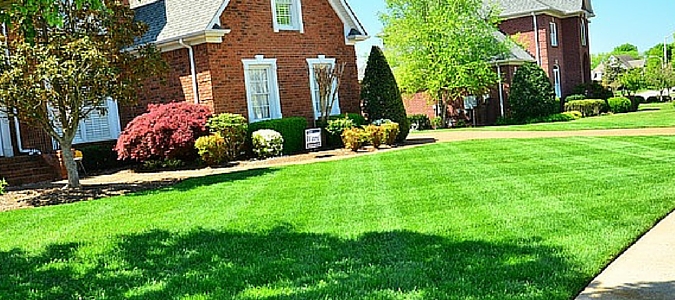
Weather extremes impact our lawns and landscaping.
With the recent drought followed by torrential rains here in Bryan-College Station, your lawn might be starved of essential nutrients. The dry conditions prevented many microbes and insects from doing their job to break down organic materials, and then recent rains likely washed away trace elements your lawn needs to be healthy.
As we greet another spring in Bryan-College Station, let’s look at how you can start your lawn off right. In this article, we’ll examine some of the things you can do to improve the condition of your lawn right now, especially how and when to fertilize your lawn in the spring.
Lawn Fertilization Do’s
There’s a lot of things you can do to give your lawn a boost this spring.
Begin fertilizing warm season grasses such as St. Augustine as soon as three weeks after the last frost. In Central Texas that’s usually mid-April, so get started soon! You can fertilize up to every 8-10 weeks through the growing season, ending in October or approximately 4-6 weeks before the first expected frost.
Use a rotary or broadcast spreader if you have a large lawn, and be sure you overlap where you spread the fertilizer, so you have an even application.
Use a handheld broadcast spreader if you have a small lawn or grassy areas.
Consider aerating your soil. This can be done with a digging fork in small areas, but requires either a mower with an aerator attachment or renting a core aerator to remove plugs of soil from your lawn. By aerating your lawn you can ensure air, water and fertilizer can get down to the roots.
Instead of costly commercial fertilizers that, applied improperly, can burn your lawn and contribute to water pollution, consider compost. You can purchase compost at your local garden supply store or even make your own. Apply in the early spring and anytime you aerate your soil or overseed the lawn.
Add clover to your lawns. As a legume, clover helps to build nitrogen in your soil and provides additional green cover and drought tolerance.
When purchasing commercial fertilizers, consider slow-release fertilizers, which allow nutrients to break down over time. These fertilizers don’t need to be applied as often as fast-acting versions and are much less likely to burn your lawn.
Know your labels. All fertilizers have three numbers that indicate the amount of nitrogen, phosphate, and potassium (in alphabetical order!), the three nutrients that all green plants need to grow. The best spring fertilizer is 20-5-10 lawn fertilizer that contains 20% nitrogen, 5% phosphate, and 10% potassium.
Lawn Fertilization Don’ts
Don’t apply fertilizer right before forecasts call for heavy rain, as the fertilizer will be washed away, wasting your money and time and polluting the waterways.
Don’t apply fertilizer to stressed lawns during a drought or in the heat of summer when the grass has turned brown.
Don’t leave spilled fertilizer on sidewalks or driveways. Instead, sweep it up, so it doesn’t get washed into local creeks and rivers.
Don’t throw out your grass clippings. Mulched grass clippings that you return to your lawn can cut your need for fertilizer by as much as 25-50%.
Don’t forget to feed your lawn in the early fall! The grass is still growing in September but may have exhausted the spring application of fertilizer. For an extra boost, you can feed your lawn in the autumn four to six weeks before the first freeze.
When to Call out the Experts
Don’t let your lawn get the best of you!
When you need help getting your lawn back into tip-top condition, the experts at ABC Home and Commercial Services Bryan-College Station are there for you. We can send out experts in lawn care services to fertilize your lawn as often as necessary for your particular grass mix, and we can provide aeration and other maintenance services such as mowing, weed and insect control, and irrigation installation.
At ABC Home and Commercial Services Bryan-College Station, we make sure your lawn gets the attention it needs.